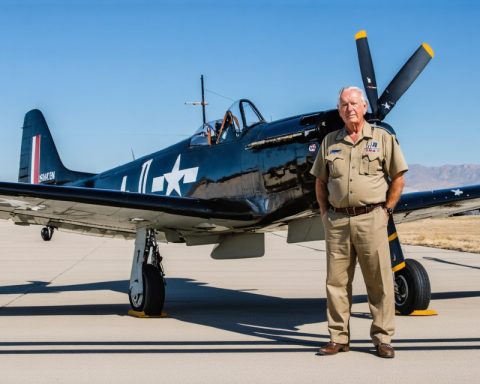- Flight 2983, a Delta Air Lines jet, had a close encounter with four U.S. Air Force T-38 Talon jets over Washington.
- The FAA is investigating the incident, which occurred during a time intended for a flyover at Arlington National Cemetery.
- Quick actions by the Delta flight crew, guided by traffic collision avoidance systems, prevented a midair collision.
- Delta Air Lines praised its crew for following protocol and ensuring passenger safety, demonstrating effective crisis management.
- Similar incidents have prompted increased regulatory vigilance and scrutiny of military and civilian airspace activities nearby.
- With over 15,000 close calls documented recently at National Airport, the FAA emphasizes the importance of aviation safety and oversight.
- Ongoing efforts aim to prevent disasters by ensuring that close encounters remain just that—avoiding any real tragedy.
Amid the humid haze of a Washington afternoon, a Delta Air Lines jet soared into the sky, its engines roaring with promise. Flight 2983 had been given the green light, its trajectory set from Reagan National Airport to the bustling city of Minneapolis. But on this day, the open sky held unexpected visitors—four U.S. Air Force T-38 Talon jets slicing through the air in tight formation. Their mission: a solemn flyover at Arlington National Cemetery.
The Federal Aviation Administration has launched an investigation into a precarious dance of metal and air that transpired approximately at 3:15 p.m. As the Delta flight climbed, its high-tech guardian, the traffic collision avoidance system, shrieked a warning—proximity had crossed a dangerous line. The Air Force jets loomed too close, a choreography that was never meant to unfold.
Inside the Delta cockpit, the flight crew acted with precision and poise. The alert system, a sentinel against midair disaster, commanded an aerial ballet—a quick climb upward for one and a descent for another. Simultaneously, ground controllers orchestrated a verbal symphony, guiding the aluminum birds to safer passages through the sky.
Though the incident finished with no damage or injury, the skies over Washington held their collective breath until the Delta plane touched down safely in Minneapolis. Delta Air Lines, steadfast in its dedication to its passengers, praised its crew for their unerring adherence to protocol—a testament to rigorous training and calm under pressure.
This close shave arrives months on the heels of a tragedy when American Airlines Flight 5342 met disaster with a Black Hawk helicopter. An incident that seared itself into aviation history with a loss of 67 souls has left open wounds and relentless scrutiny. Congressional murmurs have grown louder, echoing through committee rooms as military operations near commercial hubs face their most zealous examination in recent memory.
Despite the shadows of concern, an overarching narrative emerges—a call for heightened vigilance. The FAA, prompted by past heartbreak, has responded with regulatory vigor. The helicopter route of January’s ill-fated collision stands closed, a reminder of lessons painfully learned. And now, with more than 15,000 close calls documented over recent years at National Airport alone, the skies of Washington—and its vigilant watchers—await the unfolding horizon of policy and safety.
In this tale of air and caution, the key takeaway emerges as clear as the brightest runway lights: the skies demand respect and rigor. With every flight, each maneuver, and moment of airborne grace, a tapestry of trust in technology, human skill, and regulatory oversight is woven anew. As travelers and air crews alike look skyward, the silent promise remains—every effort bends toward safety, embodying the shared commitment to a future where the closest of calls remain just that: close, yet safely far from disaster.
Avoiding Midair Collisions: The Untold Stories Behind Averted Disasters
Aerial Safety: The Intersection of Human Skill and Technology
In the aviation world, near misses serve as stark reminders of the complex ballet that unfolds daily in the skies. They underscore the synergy between finely-tuned technologies and the human expertise that maneuvers vast metal wings through invisible corridors. The recent incident involving a Delta Air Lines flight and U.S. Air Force T-38 Talon jets highlights several facets not extensively explored.
How-To Strengthen Midair Collision Avoidance
1. Enhance Traffic Collision Avoidance Systems (TCAS): Regular updates and rigorous testing ensure that these systems function optimally to prevent close encounters.
2. Pilot Training Programs: Continuous simulation training for pilots to react promptly to TCAS alerts can enhance response times and decision-making during emergencies.
3. Cross-Agency Communication: Improved communication protocols between commercial and military air traffic controllers can help in managing airspace intersections.
Real-World Innovations and Industry Trends
– AI in Air Traffic Control: Artificial intelligence and machine learning are being increasingly integrated to predict potential conflicts and optimize flight paths. AI systems can learn from data of near misses, thereby constantly improving accuracy.
– UAS Traffic Management: With the growth of unmanned aerial systems (drones), traffic management strategies are in development to prevent incidents involving an ever-diversifying aerial mix.
Market Forecasts & Industry Trends
– Safety System Integration: The aviation safety market is projected to grow significantly, with focus areas such as enhanced TCAS, better cockpit displays, and predictive analytics systems.
– Advanced Air Mobility: As urban air mobility (UAM) develops, new protocols for airspace management are expected, potentially influencing collision avoidance strategies.
FAA Oversight and Congressional Scrutiny
The historical collision involving American Airlines and a Black Hawk helicopter prompted increased congressional focus on flight safety, specifically around major commercial hubs. This scrutiny has resulted in:
– Policy Revisions: FAA has enacted tighter regulations on helicopter flight paths and military exercises in civilian airspace.
– Funding for Research: Enhanced budgets for developing next-generation air traffic control systems.
Pressing Questions Answered
– Why Do Near Misses Continue to Occur? Near misses often result from complex factors including human error, equipment malfunction, and unpredictable weather. Advanced technologies and training continuously work to mitigate these risks.
– What Is Being Done to Increase Safety? Through collaboration between aerospace manufacturers, airlines, and regulatory bodies, continuous improvements to technology and airspace management practices are being pursued.
Conclusion: Actionable Recommendations
1. Stay Informed: Frequent flyers should keep abreast of updates from aviation safety authorities. Resources like the FAA website provide insights into ongoing safety measures.
2. Support Technological Advancements: Advocacy for the development and implementation of advanced safety technologies can help in increasing overall flight safety.
3. Participate in Safety Drills: For aviation professionals, engaging in regular safety drills and simulations is crucial.
In summary, while technology continually advances to improve safety, the collaboration and vigilance of human operators remain pivotal. As the FAA and other aviation authorities work tirelessly toward safer skies, the ultimate goal is a future where potential disasters are preemptively managed before even becoming near misses. For more information on aviation safety and updates, visit the Federal Aviation Administration.









